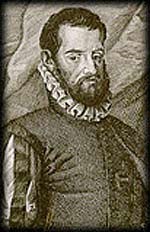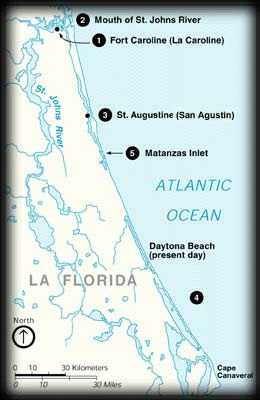|
The European history of Fort Matanzas National Monument begins with an incident almost 200 years before the construction of the fort at Matanzas - the Spanish massacre of French forces in 1565. It took place near or possibly within the area which now makes up the monument. The incident initiated Spanish control of Florida for 235 years and led to the naming of the Matanzas River. 
When King Philip II of Spain learned that the Frenchman Rene de Laudonniére had established Fort Caroline in Florida (1 on map), he was incensed -- the colony sat on land belonging to the Spanish crown. Spanish treasure fleets sailed along the Florida coast on their way to Spain and Fort Caroline provided a perfect base for French attacks. Worst of all to the devoutly Catholic Philip, the settlers were Huguenots (French Protestants). Despite Philip's protests, Jean Ribault sailed from France in May 1565 with more than 600 soldiers and settlers to resupply Fort Caroline. 
At the same time, Menéndez led a force to attack Fort Caroline. Since most of the soldiers were absent, Menéndez was easily able to capture the French settlement, killing most of the men in the battle. Some of the inhabitants, including de Laudonniére and the artist Jacques LeMoyne, were able to escape to ships and return to France. Menéndez spared the women and children and sent them by ship to Havana. He then learned from Timucuan Indians that a group of white men were on the beach a few miles south of St. Augustine. He marched with 70 soldiers to where an inlet had blocked 127 of the shipwrecked Frenchmen trying to get back to Fort Caroline (5 on map). With a captured Frenchman as translator, Menéndez described how Fort Caroline had been captured and urged the French to surrender. Rumors to the contrary, he made no promises as to sparing them. Having lost most of their food and weapons in the shipwreck, the French did surrender. Francisco Mendoza, the Chaplain accompaning Menéndez, requested the chance to offer survival for those found to be Catholics, most refused. 111 Frenchmen were killed. Only sixteen were spared - a few who professed being Catholic, some impressed Breton sailors, and four artisans needed at St. Augustine. Two weeks later the sequence of events was repeated. More French survivors appeared at the inlet, including Jean Ribault. On October 12 Ribault and his men surrendered and met their fate. This time 134 were killed. From that time, the inlet was called Matanzas -- meaning "slaughters" in Spanish. Was this a cruel, cold-hearted act by the Spanish? Was Pedro Menéndez blindly following orders to rid Florida of the interlopers? Was it a religious conflict? What would the French have done to the Spanish if the hurricane had not wrecked their ships? Maybe there is even more involved. With food already low and no chance for resupply until spring, would there have been food and shelter for all if the French had been brought back to the new village of St. Augustine? Perhaps, as leader of his people, Menéndez knew that survival of the French in October might have meant the starvation of everyone by May. |
Last updated: May 8, 2020
